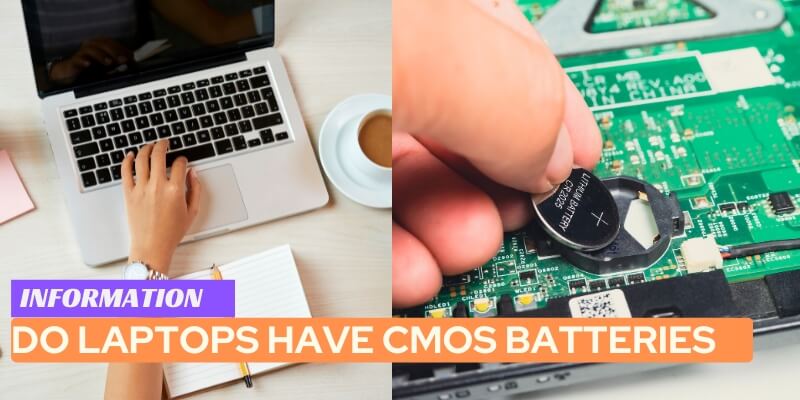Yes, laptops do have CMOS batteries. These batteries help maintain the laptop’s BIOS settings, such as the date and time, even when the laptop is turned off or disconnected from the power source.
Laptops have become an integral part of our lives, allowing us to work, connect, and stay entertained on the go.
From sleek ultrabooks to powerful gaming laptops, these portable devices have evolved rapidly over the years.
However, despite their advanced features, it’s easy to overlook certain components that play a crucial role in their functioning.
One such component is the CMOS battery. While many people are aware of the main battery that powers the laptop, the CMOS battery operates differently.
We will explore the role of CMOS batteries in laptops and discuss their importance in maintaining essential settings, ensuring a smooth user experience.
Table of Contents
Understanding Cmos Batteries In Laptops
When it comes to laptops, have you ever wondered about the tiny yet crucial component called CMOS batteries? These batteries play an important role in the overall functionality of laptops.
In this article, we will delve deeper into what CMOS batteries are, their role in laptops, and how they differ from regular laptop batteries.
1. What Are Cmos Batteries And Their Role In Laptops?
CMOS batteries, also known as complementary metal-oxide-semiconductor batteries, are small batteries found in laptops that power the CMOS chip.
This chip is responsible for storing important information such as the system’s date, time, and hardware configuration.
The CMOS battery ensures that this information is retained even when the laptop is turned off or disconnected from the power source.
2. The Importance Of Cmos Batteries In Laptop Functionality
CMOS batteries are essential for maintaining the laptop’s functionality. Without a working CMOS battery, your laptop may encounter various issues, such as:
- The system’s clock resetting to a default date and time.
- Loss of customized hardware settings, such as boot device priority or BIOS configurations.
- Failure to start up or boot properly.
It is worth noting that CMOS batteries have a limited lifespan, typically ranging from two to ten years. Over time, they may lose their charge, leading to the aforementioned issues.
To ensure smooth operation, it is recommended to replace the CMOS battery when necessary.
3. How Cmos Batteries Differ From Regular Laptop Batteries
It is important to understand that CMOS batteries are different from regular laptop batteries.
While regular laptop batteries provide power to run the laptop when it is not connected to an external power source, CMOS batteries serve a completely different purpose.
Regular laptop batteries, often referred to as primary or main batteries, are responsible for powering the laptop itself.
They are rechargeable and provide power to the laptop for extended periods. On the other hand, CMOS batteries are small, non-rechargeable batteries that solely provide power to the CMOS chip, ensuring the retention of important system information.
In conclusion, CMOS batteries play a vital role in laptops by keeping the system’s date, time, and hardware configuration intact.
Regular laptop batteries, on the other hand, power the laptop itself. Understanding the difference between these two types of batteries is crucial for troubleshooting and ensuring the smooth functioning of your laptop.
The Functionality Of Cmos Batteries
CMOS batteries play a crucial role in the functionality of laptops. These small, coin-shaped batteries are responsible for retaining important BIOS settings, maintaining accurate time and date settings, and ensuring smooth startup processes.
In this section, we will delve deeper into the specific functionalities of CMOS batteries, exploring how they retain BIOS settings, their role in maintaining time and date settings, as well as their impact on laptop startup processes.
1. How Cmos Batteries Retain Bios Settings In Laptops
CMOS batteries are integral in retaining the BIOS (Basic Input/Output System) settings in laptops.
The BIOS is a firmware that resides on the motherboard and is responsible for managing various hardware components.
When a laptop is powered off, the CMOS battery ensures that the BIOS settings, such as boot order and hardware configurations, are preserved even without a constant power supply.
2. The Role Of Cmos Batteries In Maintaining Time And Date Settings
Besides preserving BIOS settings, CMOS batteries also play a vital role in maintaining accurate time and date settings in laptops.
Without a CMOS battery, the laptop would reset its time and date settings to a default value every time it is powered on.
This could lead to inconsistencies in file timestamps, confusion in scheduling appointments, and difficulties in troubleshooting time-sensitive issues.
3. Cmos Batteries And Their Impact On Laptop Startup Processes
One of the significant impacts of CMOS batteries on laptop functionality is their role in startup processes.
When a laptop is powered on, the CMOS battery provides power to the motherboard, ensuring that the BIOS settings are accessible and ready for use.
This reliable power supply ensures that the laptop starts up smoothly and that the operating system can load without any configuration errors.
Signs Of Cmos Battery Failure
1. Identifying Common Symptoms Of A Failing Cmos Battery In Laptops
CMOS (Complementary Metal-Oxide-Semiconductor) batteries play a crucial role in maintaining the system clock and storing BIOS settings of laptops.
Over time, these tiny rechargeable batteries can fail, leading to various issues with your device’s performance.
It’s important to be aware of the signs that indicate a failing CMOS battery so that you can take appropriate measures to rectify the problem.
Here are some common symptoms to look out for:
- Inaccurate system clock: A depleted CMOS battery often causes the system clock to lose its accuracy.
You may notice that the time and date settings constantly reset to default or differ significantly from the current time, despite setting them correctly. - BIOS settings reset: Another telltale sign is when the BIOS settings keep reverting to their default values.
This can result in issues such as unrecognized hardware, incorrect boot order, and disabled features that were previously enabled. - Failure to boot or boot errors: A failing CMOS battery can lead to boot problems, such as the laptop failing to start up altogether or displaying error messages during the boot process. These errors may include “CMOS Checksum Error” or “CMOS Battery Low.”
- Intermittent display issues: If you experience sporadic display problems, such as flickering or distorted screens, it could be an indication of a failing CMOS battery.
The battery’s inability to store consistent video settings can contribute to these issues. - Unsaved BIOS changes: Changes made to the BIOS settings might not be saved when you power off or restart your laptop. This can be frustrating, especially if you need to tweak settings for optimal performance.
2. The Effects Of A Dead Cmos Battery On Laptop Performance
A dead CMOS battery can negatively impact the overall performance of your laptop. Here’s how:
- Time-related issues: Since the system clock relies on the CMOS battery, its failure can cause time-related inconveniences. This includes incorrect timestamps on files, emails, and software that rely on accurate time data.
- Boot problems: A dead CMOS battery may prevent your laptop from booting up or cause frequent boot errors. This can disrupt your workflow and make it difficult to access your files and applications.
- Hardware recognition issues: Without a functional CMOS battery, your laptop may fail to recognize various hardware components. This can lead to compatibility problems and prevent devices like USB drives or external monitors from working correctly.
- Inconsistent BIOS settings: A dead CMOS battery results in the loss of BIOS settings, forcing your laptop to use default values. This can affect system stability, performance, and the functionality of features like overclocking or power management.
3. Troubleshooting Techniques To Confirm Cmos Battery Failure
If you suspect that your laptop’s CMOS battery is failing, you can perform a few troubleshooting techniques to confirm the issue:
- Check the system clock: Pay attention to the accuracy of the system clock when you power on your laptop. If it consistently displays the wrong time or resets upon every boot, it’s a strong indication of CMOS battery failure.
- Document BIOS settings: Take note of your current BIOS settings and make any necessary changes. Then, power off your laptop and observe if the settings revert to default when you power it back on. If they do, it points to CMOS battery failure.
- Replace the CMOS battery: The most definitive way to confirm CMOS battery failure is by replacing it. CMOS batteries are typically accessible through the laptop’s motherboard or a dedicated compartment.
Consult your laptop’s user manual or manufacturer’s website for specific instructions on replacing the battery. - Consult a technician: If you are unsure about replacing the CMOS battery yourself or if the troubleshooting techniques don’t provide a clear answer, it’s advisable to seek assistance from a trained technician.
They can diagnose the issue accurately and recommend the necessary steps to resolve it.
Being aware of the signs of CMOS battery failure and how it may affect your laptop’s performance can help you resolve the issue promptly.
By troubleshooting and replacing the failing battery, you can restore your laptop’s functionality and ensure smooth operation.
Steps To Replace Cmos Batteries In Laptops
If you’re facing issues with your laptop’s time and settings resetting, it’s possible that the CMOS battery needs to be replaced.
The CMOS battery is responsible for powering the complementary metal-oxide-semiconductor (CMOS) chip, which stores your computer’s BIOS settings.
In this article, we will guide you through the process of replacing the CMOS battery in laptops.
1. Understanding The Accessibility Of Cmos Batteries In Different Laptop Models
Before replacing the CMOS battery in your laptop, it’s essential to understand that laptop manufacturers have varying designs when it comes to accessing the CMOS battery.
Some laptops have easily accessible CMOS batteries, while others require partial disassembly of the laptop to reach the battery.
Here’s a breakdown of the different accessibility scenarios:
| Laptop Model | CMOS Battery Accessibility |
|---|---|
| Dell Inspiron 15 | Easily accessible by removing the laptop’s bottom cover |
| HP Pavilion x360 | Requires partial disassembly to access the CMOS battery |
| Lenovo ThinkPad T480 | Accessible by removing the keyboard and bottom cover |
2. Tools And Precautions Required For Safe Cmos Battery Replacement
Now that you have an idea of how to access the CMOS battery in your laptop model, let’s gather the tools you’ll need and discuss the precautions to ensure a safe replacement process:
- A small screwdriver or a precision tool kit
- An anti-static wrist strap or mat to prevent Electrostatic Discharge (ESD)
- A replacement CMOS battery (make sure to check your laptop’s specifications for the correct battery model)
- Disconnect the laptop from the power source and remove the battery
- Handle the CMOS battery with care, avoiding any unnecessary pressure or force
- Follow the manufacturer’s instructions and warnings mentioned in the laptop’s user manual
3. Step-by-step Guide For Replacing Cmos Batteries In Laptops
Now that you are equipped with the necessary tools and precautions, let’s dive into the step-by-step process for replacing the CMOS battery in your laptop:
- Turn off your laptop and unplug it from the power source.
- Use a small screwdriver or precision tool kit to remove the necessary screws to access the CMOS battery. Refer to your laptop’s user manual or online resources for guidance specific to your laptop model.
- Once you have accessed the CMOS battery, carefully remove it from its socket. Pay attention to how the battery is connected as you will need to reconnect the new battery in the same way.
- Place the new CMOS battery into the socket, ensuring it is securely connected. Take note of the positive (+) and negative (-) signs on the battery to align them correctly.
- Reassemble the laptop by following the reverse order of the disassembly steps. Make sure to tighten any screws that were loosened during the process.
- Finally, reconnect the laptop to the power source and insert the battery. Power on the laptop and check if the time and settings are now being preserved correctly.
Congratulations! You have successfully replaced the CMOS battery in your laptop.
Always remember to handle electronic components with care and follow the precautions mentioned to avoid any damage during the replacement process.
If you are unsure about any step or encounter difficulties, it’s recommended to consult a professional technician for assistance.
Extending The Lifespan Of Cmos Batteries
1. Tips And Best Practices To Prolong Cmos Battery Lifespan
If you want to ensure that your laptop’s CMOS battery lasts as long as possible, there are a few tips and best practices you can follow.
By implementing these simple strategies, you can extend the lifespan of your CMOS battery and minimize the hassle of frequent replacements.
- Minimize unnecessary power drain: One of the primary causes of CMOS battery drain is unnecessary power consumption. To avoid this, make sure to disconnect any peripherals or devices that are not in use.
This includes external hard drives, USB devices, and even Wi-Fi adapters when you’re not actively using them. - Regularly power on your laptop: Although it might be tempting to leave your laptop in sleep mode or hibernation for extended periods, it’s essential to power it on at least once a week.
This allows the CMOS battery to recharge and maintain its optimal performance. - Avoid extreme temperature conditions: Extreme temperatures, both hot and cold, can have a detrimental effect on the lifespan of your CMOS battery.
Try to keep your laptop in a temperature-controlled environment to prevent unnecessary strain on the battery. - Keep your laptop clean and dust-free: Dust and dirt can accumulate within your laptop over time, leading to increased heat and power consumption.
Regularly clean your laptop’s ventilation system and ensure proper airflow to keep your CMOS battery at optimal temperatures.
2. The Impact Of Laptop Usage Patterns On Cmos Battery Longevity
Your usage patterns can have a significant impact on the lifespan of your laptop’s CMOS battery.
Here’s how you can optimize your laptop usage to maximize the longevity of your CMOS battery:
- Avoid excessive multitasking: Running multiple resource-intensive applications simultaneously can strain your CMOS battery. Try to minimize multitasking and close unnecessary applications to conserve power.
- Optimize power settings: Adjusting your laptop’s power settings to favor lower power consumption can help prolong the life of your CMOS battery.
Lowering screen brightness, reducing the display timeout, and enabling power-saving modes can go a long way in reducing power drain. - Manage background processes: Many applications run background processes that consume power even when you’re not actively using them. Check your task manager and disable unnecessary background processes to preserve your battery life.
3. Alternative Power Solutions To Reduce Cmos Battery Drain
If you need to minimize CMOS battery drain further, there are alternative power solutions you can consider:
————————————————–
| Alternative Power Solutions |
————————————————–
| Solar chargers |
————————————————–
| External power banks |
————————————————–
| Laptop docking stations with AC power adapters|
————————————————–
- Solar chargers: Harness the power of the sun to recharge your laptop’s battery. Solar chargers are a sustainable and eco-friendly option for reducing CMOS battery drain.
- External power banks: Carry an external power bank to provide an additional power source when your laptop’s battery is running low. This way, you can avoid relying solely on your CMOS battery.
- Laptop docking stations with AC power adapters: Docking stations offer a convenient way to connect your laptop to a power source, reducing the strain on your CMOS battery. This is particularly useful when you’re working from a fixed location for an extended period.
By following these tips and incorporating alternative power solutions, you can take proactive measures to extend the lifespan of your laptop's CMOS battery.
With a longer battery life, you can enjoy uninterrupted productivity and reduce the hassle of frequent replacements.
Frequently Asked Questions Of Do Laptops Have Cmos Batteries
Where Is Cmos Battery In Laptop?
The CMOS battery in a laptop is typically located on the motherboard. It can usually be found underneath the keyboard or in a bottom compartment.
Should I Replace Laptop Cmos Battery?
Yes, you should replace the laptop CMOS battery. It helps retain important system information, like the date and time, even when the laptop is turned off. A weak or dead CMOS battery can cause issues like system clock errors or booting problems.
Do Laptops Have Cmos Batteries?
Yes, laptops have CMOS batteries that help store date and time settings even when the laptop is turned off.
How Long Does A Cmos Battery Last In A Laptop?
CMOS batteries in laptops typically have a lifespan of 2 to 10 years, depending on usage and battery quality.
Can I Replace The Cmos Battery In My Laptop?
Yes, most laptops have replaceable CMOS batteries which can be easily accessed and swapped out if needed.
What Happens If The Cmos Battery Dies In My Laptop?
If the CMOS battery dies in your laptop, you may experience issues with booting up, date/time reset, or BIOS settings.
How Can I Check If The Cmos Battery Is Working In My Laptop?
You can check if the CMOS battery is working by accessing the BIOS settings and checking the date/time settings.
Can A Faulty Cmos Battery Cause Performance Issues In My Laptop?
While a faulty CMOS battery can potentially cause booting or BIOS-related issues, it typically does not directly affect overall performance.
Is It Possible To Fix A Faulty Cmos Battery In A Laptop?
No, a faulty CMOS battery cannot be fixed and needs to be replaced with a new one.
Where Can I Buy A Replacement Cmos Battery For My Laptop?
You can buy a replacement CMOS battery for your laptop from electronic stores, online retailers, or the laptop manufacturer’s website.
Conclusion on Do Laptops Have Cmos Batteries
Understanding the presence and importance of CMOS batteries in laptops is crucial for both troubleshooting and maintaining optimal performance.
These small yet powerful components play a vital role in storing essential information and preserving system settings.
By being aware of their existence, users can tackle common hardware issues and ensure their laptops function smoothly.
Remember, while not all laptops have CMOS batteries, it is always helpful to know if your device does and how to address any related concerns.






